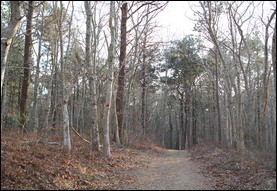 When you need a little calm and clarity, try taking a walk in the woods. |
My town is 20% green spaces plus water views across two ponds. That’s a lot of open space for a town less than 5 square miles with about 25,000 residents.
What’s more, though my town is really a semi-urban suburb, it likes to think of itself as a simple New England town with a small town ambiance. Good zoning and design control have worked together to accomplish this, as it tries to keep the feeling of a little old town of memory.
This is going to be a mushy, pseudo-neurological, touchy-feely column. About feelings, and the use of green spaces around town, gardening, and maybe even a subconscious memory of the primeval forest.
Neuroscience is the current rage, and the science is fascinating. So many new ideas, like what do mice think about when they’re in a maze. Or how do humans really think, particularly when they make decisions. And how do our moods influence what we believe to be rational thinking, but which is often emotion driven habit.
What does this have to do with open space? Supposedly, green space calms the mind. Or so think people who dwell on how we feel and what makes us feel good.
After a memorial service for a friend, I asked lots of people what they do when they feel troubled and sad. Most said they would walk in the woods.
I had asked for a one sentence only and was surprised at how many choose a walk in the woods. Many different kinds of people. All seemed to feel there was something calming and peaceful under trees and in open space. Even small spaces. It relieved anxiety.
Think of Buddha who found enlightenment sitting under the Botree (Ficus religiosa). It has heart shaped leaves, with a pointed tip from which water droplets fall. Mesmerizing and mystical to watch. And silently meditate. This led to whole religions that aim to find peace and Nirvana.
Or think of relaxation response therapy. Find a comfortable, quiet place, and repeat a mantra. Over and over. (Ommn, ommn, ommn with the m+n sound is classic.) The quiet repetition is supposed to help turn off stress hormones and the alarm response (and maybe benefit the cerebral cortex, hypothalamus, pituitary and adrenal). How nice this relaxation therapy would be under a tree, though it can be practiced anywhere.
 Even the woods in the wintertime can provide peaceful vistas to lose oneself in. |
One troubled friend regularly went to an encounter group. She told how lovely it was once when they sat and watched bright crimson maple leaves float slowly to the ground. Slowly. Is that the important word in these rush-rush electronic times?
In winter, one can walk and enjoy the long vistas. Or look up, through leafless trees, and see the whole blue sky. Clouds moving slowly. Or one can sit on a bench and do email or twitter if slowly is just too, too slow.
There was a newspaper story about how many words we now read a day. 100,000, I think I recall. Which is lots more than a few years ago when we didn’t have smart phones, apps, instant messaging, social sites, etc.
One gardening friend said she preferred to prune the bushes when she felt troubled. Others weed or plant or plan. However, my favorite answer was from a psychiatrist friend, who said he loved to garden because the plants don’t talk back.
So walk through the woods and fields. Maybe sit and meditate under a tree. Unwind. Enjoy the many beautiful green spaces around town, or maybe just the green space in your own back yard.
Ruth S. Foster is a landscape consultant and arborist. More gardening information can be found on her website, www.mothersgarden.net.




























